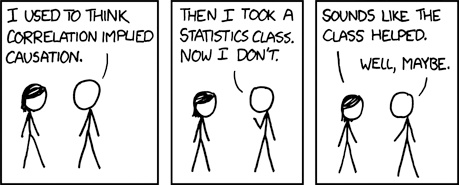Correlation and Covariance
Very often, when analyzing data, you want to know if two variables are correlated. Informally, correlation answers the question “when we increase (or decrease) x, does y increase (or decrease), and by how much?” Formally, correlation measures the linear dependence between two random variables. Correlation measures range between −1 and 1; 1 means that one variable is a (positive) linear function of the other, 0 means the two variables aren’t correlated at all, and −1 means that one variable is a negative linear function of the other (the two move in completely opposite directions; see Figure 16-1).

Figure 16-1. Correlation
The most commonly used correlation measurement is the Pearson correlation statistic (it’s the formula behind
the CORREL function in
Excel):

where x̄ is the mean of variable x, and ȳ is the mean of variable y. The Pearson correlation statistic is rooted in properties of the normal distribution and works best with normally distributed data. An alternative correlation function is the Spearman correlation statistic. Spearman correlation is a nonparametric statistic and doesn’t make any assumptions about the underlying distribution:

Another measurement ...
Get R in a Nutshell now with the O’Reilly learning platform.
O’Reilly members experience books, live events, courses curated by job role, and more from O’Reilly and nearly 200 top publishers.

